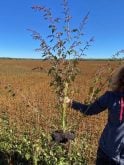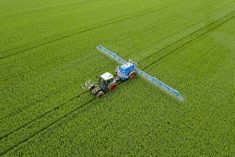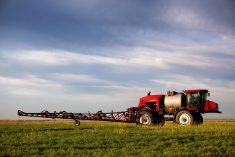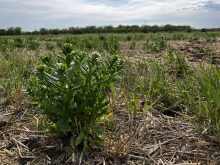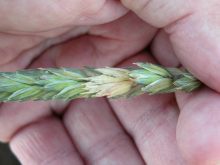Sometimes potato plants show no signs of damage, but tuber germination can suffer and only be discovered the following year
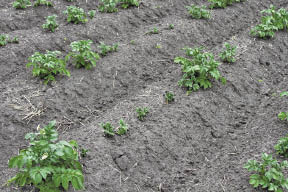
 When it comes to seed potatoes and herbicide drift, what you can’t see can hurt you.
When it comes to seed potatoes and herbicide drift, what you can’t see can hurt you.
Read Also

Manitoba sclerotinia picture mixed for 2025
Variations in weather and crop development in this year’s Manitoba canola fields make blanket sclerotinia outlooks hard to pin down
Increased use of glyphosate as a pre-harvest burn-down, as well as increased acreage for Roundup Ready corn and soybeans, has upped the use of the ubiquitous herbicide — and that’s upped the risk for seed potato growers.
“If it’s a systemic (herbicide) product, it will be translocated into the tubers and that’s the concern,” said Jeremy Kuhl, a director with the Seed Potato Growers Association of Manitoba.
“You might not see the drift on the plant, but the glyphosate will be present in the tubers and it will either delay or inhibit emergence of the daughter tubers for the following crop.”
The association has launched an awareness campaign to alert neighbours and custom herbicide applicators about seed potatoes’ sensitivity to herbicide drift.
“We really need to communicate and work together with our neighbours to make them aware of the concerns,” said Kuhl, who is vice-president of seed potato and rotational crops with the Southern Manitoba Potato Co.
“It’s obviously not just a concern on potatoes. Drift is a concern in any situation.”
However, when glyphosate drifts into a neighbour’s field of canola the damage is usually visible seven to 10 days later, and so calculating the compensation is relatively straightforward.
But damage to seed potatoes may not show up until the potato grower who planted the affected seed complains about poor germination the following year. That farmer might want a refund or to be compensated for lost revenue. The latter could be a big bill given potatoes are a high-gross-revenue crop.
In some cases, commercial herbicide applicators won’t have enough insurance to cover the damage, while farmers often have general liability insurance, which might not cover herbicide drift damage to a neighbour’s crop, the association said in a news release.
As well, some Group 2 herbicides commonly used on cereal crops may persist in soil affecting potatoes the following season, the association said in a brochure. Group 2 herbicides can also persist in spray tanks that haven’t been adequately cleaned, and even low levels can cause significant injury to potato crops.
The publication has the following advice:
- Understand the product you are spraying and follow the label recommendations.
- Know what crops are adjacent to the field you are spraying.
- Leave an unsprayed headland next to sensitive crops such as potato, until the wind is favourable.
- Know the wind speed and direction prior to application.
- Avoid spraying at high temperatures with low relative humidity.
- Keep spray application records.
- Use low-drift nozzles. Manage air pressure to reduce the number of fine droplets. Maintain appropriate boom height. Manage ground speed to avoid boom bounce. Clean the spray tank thoroughly to avoid contamination.
- If using a custom applicator, ensure he or she is certified and understands the risks to non-target crops such as potatoes.
There are about 16 potato seed growers in Manitoba producing between 6,000 and 7,000 acres of seed annually, Kuhl said.
“It’s a fairly intensive crop,” he said. The seed farms manage a lot of different varieties. Most of the seed farms don’t have a large acreage of any variety.
“It’s a fantastic business… but we’re trying to protect ourselves to make sure we’re viable for years to come.”









